Wright Case Highlights FCC's Petition Black Hole
The above snapshot of the FCC's home page today shows FCC crowing about its success in the Wright Petition case dealing with inmate call rates. While this Title II proceeding has little to do with spectrum policy it highlights the little known details about how the FCC's "petition black hole" works. The right to petition the federal government is one guaranteed by the 1st Amendment and the APA (5 U.S.C. 553(e)). FCC has implemented this requirement with 47 C.F.R. 1.401. But all this means nothing if petitions fall into an administrative black hole where they can not be seen, let alone acted on!

"These cases raise issues that are of great human concern to inmates, their family members and their counsel. . . . In referring this matter to the FCC, the Court expects the agency to move with dispatch to conclude its ongoing proceedings so as to provide both courts and parties with meaningful analysis and guidance on these issues." (Emphasis added.)
So this case was not a random petition that just wandered into the FCCs inbox, it came with the urging of a federal judge to "move with dispatch" and even then FCC frittered away years on inaction!
Petitions from techies for new spectrum rules or even waivers also can be caught in the FCC's petition back hole for years. The NPRM in Docket 13-111 on contraband cellphone use in prison accidentally gave a clue about the petition blackhole at FCC. The drafters of this NPRM had the award issue of how to deal with several petitions relating to it that had been gathering dust for years without even a request for public comments.
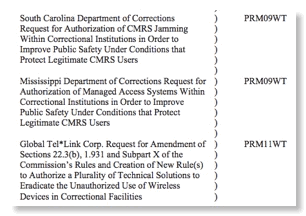
The drafters dealt with this awkward issue by identifying the petitioners with their index numbers in ECFS using a scheme that had never been revealed to the public and was not even widely known within FCC. So if you input into ECFS "PRM14WT" you get back a list of all petitions that were assigned to the Wireless Telecom Bureau, correctly or not, in 2014. There you will find that a petition from key industry player Land Mobile Communications Council was filed on 05/15/2014 and public comments were requested on 07/21/2014 as RM-11722 . But petitions from the more obscure Mark Friedlander and Cord Davidson remain in the FCC's black hole, nether having been dismissed nor having been put out for public comment.
So here is a concrete suggestion to address the root cause of the Wright Petition delay and delays of petitions lingering in the black hole: FCC should establish an online database of all petitions for rulemaking and waivers within a few weeks of their filing at FCC that identifies which bureau they have been assigned to (something that is sometimes in error) as well as stating what the current status of the petition is, e.g. without any action, dismissed, public notice requesting comments has been issued, NPRM issued, etc. FCC should also public statistics on time to resolve such petitions. So while today's commissioners decree the delay of the Wright Petition, let's make sure that never happened again in either technical or nontechnical proceedings at FCC.
ICYMI: @FCC takes a big step to reduce inmate calling rates. Details: https://t.co/4o2A10i58P
— The FCC (@FCC) October 27, 2015TPRC Paper on FCC Spectrum Policy Throughput

On Thursday 9/17 TRDaily, a prominent communications policy newsletter, published an article about your blogger's paper for next weekend's 2015 TPRC | 43rd Research Conference on Communications, Information and Internet Policy (formerly Telecommunications Policy Research Conference). The previous link goes to the paper that can be downloaded for free.
The paper does not criticize any specific FCC decisions, rather it is concerned about the speed and transparency of such decisions. The concerns raised in the paper are not due to any one chairman or one party, rather they are issues that have developed in the past 20-30 years under multiple leaders.
Here is the abstract:
Today’s FCC is not as well structured to handle the reality of its spectrum policy workload as the early Commission was and may not be even keeping up with workload. Indeed, there is increasing evidence that “triage” is a key issue in spectrum policy. That is the nontransparent decision to even address an issue is a major determinant of its outcome. This could be both deterring capital formation for new spectrum technology R&D as well as creating real risks for incumbent licensees since emerging interference issues that need rulemaking or nonroutine action are not getting resolved in a timely way.
In 1934, the new FCC took a page from the structure of the ICC, one of its predecessors, and divided the then 7 commissioners into 3 “divisions” that could operate independently in the police areas of telephone, telegraph, and radio. There was no Administrative Procedures Act (“APA”) so rule deliberations were far simpler than today. The maximum frequency in routine use was 2 MHz and the modulation choices were just AM and radiotelegraphy. In the early days, a few of the commissioners had technical experience in spectrum issues.
Today we have the APA and nearly 70 years of court decisions than make rulemaking much more complicated. We have 5 commissioners that only make decisions en banc with virtually no §5(c) delegation to staff on emerging issues. Allocations go to 275 GHz, but service rules have been stuck at a 95 GHz limit since 2003. The selection process for commissioners appears to be focused on nonspectrum and nontechnical issues.
The result of all these factors is long drawn out deliberations on both new technology issues and on resolution of merging interference issues. While the US’ economic competitor nations often use “state capitalism” as a key issue in spectrum policy by subsidizing chosen new technologies and then cooperating to remove national and international spectrum policy limits for them, US entities in spectrum R&D often face both a lack of funding and an indifferent FCC (as well as NTIA - if access to G or G/NG spectrum is at issue).
The paper looks at a variety of spectrum policy issues FCC had dealt with since 2000 and examine the delays involved and their impacts. The issues consider include new technology issues such as the TV White Space, the FWCC 43 GHz petition and the Battelle 105 GHz petition as well as emerging interference issues such as police radar detector/VSAT interference, cellular booster-related interference, and FM broadcast/700 MHz LTE interference. The time lines of such deliberations will be reviewed as well as the likely impact of these timelines on the business plans of FCC regulatees.
Finally possible options to improve FCC throughput that are both feasible within existing legislation and consider approaches successfully used in foreign spectrum regulators will be discussed.
Should FCC Clean Up Its Spectrum Policy Backlog Before Reviewing Another Cable Merger?
Charter Communications expected to acquire Time Warner Cable in $55 billion deal http://t.co/jzM3wSG7NQ
— Washington Post (@washingtonpost) May 25, 2015This weekend word broke on yet another cable merger. We have no view on the merits of this merger, or for that matter on the merits of most mergers. But such mergers compete for scarce attention at FCC as it presently operates and detracts from its other duties such as Title III technical policy issues other than more spectrum below 5 GHz for the cellular industry. Even though the merger has not even been formally filed, Chmn. Wheeler has already issued today a public statement before 8:45 AM promising to review it. At least he did not promise quick action.
But what about the statutory promise of 47 USC 157(b) for timely action on “new technology” deliberations? What about new technology deliberations at FCC that seem to be stalled? For example:
- Wireless Innovation NOI - Docket 09-157 (8/27/09)
- Petition of South Carolina Department of Corrections and 30 other state corrections agencies on jamming cell phones in prisons (7/13/2009) (This was finally included in Docket 13-111 after having been never placed on notice for public comment and that docket is also languishing!)
- FWCC 42 GHz petition (5/9/12)
- Issue of interference from FM broadcast stations to 700 MHz LTE cellular base stations apparently resulting from a conflict between cellular rules and broadcasting rules (Since FCC has never acknowledged this issue, we will give it a date of 2 years ago)
- IEEE-USA petition for a declaratory ruling on whether 7 presumptively applies to technology above 95 GHz where there are presently no FCC rules (7/1/13)
- Battelle petition for Fixed service rules at 102-109.5 GHz (2/6/14)
- NOI on Mobile Service above 24 GHz (10/17/14) - Note that while not much time has elapsed, Ofcom, FCC’s UK counterpart has already issued two documents on this issue as well as a consultant’s findings since the issuance of this NOI! This is cutting edge technology moving quickly with government funding in many other countries, but uncertainties with FCC’s position are deterring private capital formation in USA in this technology.
- (While we can’t attach a date to it, the FCC’s continuing silence on all matter associated with spectrum for UAV’s/drones just drones on as the general issue of civil drones attracts ever growing attention. While there appears to be a dialogue between FAA and FCC on the issue, there is no statement on where drones may or may not use spectrum or any proposals.
Perhaps FCC has a valid viewpoint with its secret interpretation of the Communications Act that Section 5(c) trumps the Section 7 requirement on timely action for new technology. But if this is so, perhaps the Commission should tell Congress and the public that Section 7’s promise is now moot and you should expect dilatory action on everything except corporate mergers and more spectrum for cellular carriers?
In preparing for a talk this week, I was reviewing a video placed on YouTube by MobileFuture, a lobbying group representing many cellular interests. I noticed this predicted outcome of not giving cellular interests all the spectrum they want:

The irony is that the Commission’s current paralysis on more spectrum for cellular carriers and corporate mergers, not to mention partisan feuding over net neutrality, has resulted in chilling innovation for other wireless technologies not of immediate interest to the cellular industry, even backhaul technologies such as in the FWCC and Battelle petitions! As our national competitors subsidize R&D for these technologies, the US risks losing technological leadership unless FCC gives some signals to the private sector. (See p. 8-14 of NYU WIRELESS Docket 14-177 Comments)
So a modest proposal: no action on the new merger request until FCC makes real progress on cleaning up its Title III backlog.
We could point out that while FCC has made a promise on timeliness on corporate mergers, the statutory promise of Section 7 would seem to take precedence unless FCC wants to put its cards on the table and publish its secret ruling about why Section 5(c) makes that moot.
FCC Transparency & Spectrum Policy Productivity: How Many Spectrum Issues are Resolved by Letting Them Become "Dormant"?
The Chairman’s testimony is here. Here are some observations:
- The Chairman starts off with “The American people expect the Commission - and all federal agencies - to carefully consider and decide matters in a fast, fair, and effective manner.” (emphasis added) A basic problem is that spectrum policy at FCC is not “fast, fair, and effective manner” unless you are the cellular industry and even they can only get attention for megaissues like more spectrum for themselves. Even the cellular industry had to wait 10 years for FCC to act on the cellular booster interference issues in Docket 10-4 and is still waiting for more than 2 years on the FM/LTE interference issue that FCC has not publicly acknowledged. (Perhaps we should mention the police radar detector/VSAT interference issue/Docket 01-278 that also took more than a decade to address and for which FCC covered up the delay in official documents?)
- What about the continued inattention to the statutory requirements of 47 USC 157, admittedly not the most brilliantly written piece of legislation, but the “law of the land” for 30+ years. An FCC insider tells me that the view of the Chairman’s Office is that the provision of 47 USC 155(a) giving the Chairman the power “generally to coordinate and organize the work of the Commission in such manner as to promote prompt and efficient disposition of all matters within the jurisdiction of the Commission” overrides the specific language of §7 that gives deadlines for certain new technology actions. Your blogger did not go to law school and the FCBA directory has a large “N” next to his name to warn others not listen to his legal opinions, but this nonpublic interpretation of the primacy of §5 over specific statutory time limits seems a little strange! Perhaps other commissioners or the House committee could ask the Chairman to clarify how he interprets §7. (Although his interpretation is probably no different than he predecessors who have all tried hard to avoid compliance with this provision.)
- What ever happened to Docket 09-157, introduced with great fanfare to stimulate “wireless innovation”? Is it being resolved in a “fast, fair, and effective manner”? Or will it just gather dust? The Chairman brags in his testimony (p.3) that “(l)ast year, we closed more than 1,500 dockets that were dormant”. Will this be the fate of 09-157? Keep ignoring it year after year and then dismiss it as “dormant”? What about the FWCC request for new E band antenna standards that has been pending since 2012? What about the Battelle petition for 102-109.5 GHz rulemaking, a band that presently lacks any FCC rules. Indeed, all spectrum above 95 GHz lack FCC licensed or unlicensed service rules, with the minor exception of a few amateur and ISM bands. What about the 2013 IEEE-USA petition to declares spectrum above 95 GHz that have no FCC rules as “new technology”?
- These problems were not created by the current Chairman or the current commissioners, they have evolved over a long time. But it is time for the Commission to face up to that fact that its Title III productivity as presently structured and operating is not enough. It is troublesome that several commissioners think there is too much delegated authority to the staff. Some recent actions on delegated authority raise some real questions. Yet, the only way to increase productivity on Title II is to have more delegated authority that is accountable to the 8th Floor!
- Let us compare Ofcom with FCC on spectrum policy. At Ofcom there is a Board of political appointees: “ Ofcom's main decision making body is the Board, which provides strategic direction for the organisation.” The Board does not make every decision, it sets “strategic direction” and oversees Executitve Committee which is “ Ofcom's senior executive team. It meets each month (except August) and is responsible for setting Ofcom's direction and overseeing the management of the organisation.” FCC has enough flexibility under §5(c) to change its spectrum policy deliberation procedures to approach those of Ofcom if the commissioners recognize there is a real productivity shortfall right now and it is affecting US competitiveness.
- On October 17, 2014 FCC adopted the 14-177 NOI on 5G above 24 GHz. Ofcom followed on January 16, 2016 with its corresponding “Call for Input”. While FCC is still dithering with its NOI and its maze of 170+ questions, Ofcom moved ahead on April 15 with both a initial decision on “Laying the foundations for next generation mobile services: Update on bands above 6 GHz” and a contractor study on 5G candidate bands. While a 1980 FCC contractor study was key to FCC’s later actions in creating the ISM bands for Wi-Fi and Bluetooth 30 years ago, the budgetary reality is that FCC spectrum management does not have money for outside studies on topics of other than key 8th Floor interests.
- Spectrum requirements for drones have been a recurring topic in this blog, although we have advocated no specific position and have no clients in that area. Certainly the growing commercial interest in drones has been all over the place in the news in the past year. But drone proponents are not traditional players at FCC and FCC has been completely silent on drone spectrum issues, except for public safety drones. If FAA ever finishes its drone policy issues next FCC will be the roadblock! Is this a “fast, fair, and effective manner”?
If FCC had $745,603 for a contractor for a management review of spectrum enforcement, perhaps it could spend a comparable amount of money studying how it might improve its productivity in spectrum policy that in turn will stimulate the US economy and is already a major part of GDP?
If FCC acknowledges (at least internally) a Title III productivity shortfall, it might wish to consider the suggestions of IEEE-USA on “Improving U.S. Spectrum Policy Deliberations in the Period 2013-2017” that have attracted little interest in the Commission so far.
Maybe FCC is as “fast, fair, and effective” in spectrum policy as possible given the current FCC resource level appropriated by Congress. But if the endless delays that most non-CTIA related spectrum policy issues (and even many CTIA-related issues) at FCC face is adversely affecting both US spectrum technology competitiveness and the large part of the GDP impacted by mobile ICT, the Commission should tell Congress that it is now resource limited. Given the ongoing net neutrality controversy, Congress may be unwilling to give FCC a resource blank check, but maybe someway can be found to make additional resources available only for noncontroversial Title III issues.
Summarily closing thousands of dockets and enforcement cases after years of inaction is not good productivity, it is fudging the data - not unlike the actions of the Phoenix VA Hospital and their waiting list data. “Fast, fair, and effective” action would involve resolving these issues in a timely way not by letting them die a natural bureaucratic death!
.
FCC's Secret Store Room of Petitions "in Limbo"
First Amendment
Congress shall make no law respecting an establishment of religion, or prohibiting the free exercise thereof; or abridging the freedom of speech, or of the press; or the right of the people peaceably to assemble, and to petition the Government for a redress of grievances.
5 USC 552(e)
Each agency shall give an interested person the right to petition for the issuance, amendment, or repeal of a rule.

Now much to our amazement we discovered that petitions “in limbo” - those that have neither been announced for public comment nor dismissed - are not hiding in a black hole awaiting a multiyear determination of whether public moments should be requested or whether they should be dismissed. No, they are “hidden in plain sight” in an “undocumented feature” of ECFS!
§ 1.403 Notice and availability.
All petitions for rule making (other than petitions to amend the FM, Television, and Air-Ground Tables of Assignments) meeting the requirements of § 1.401 will be given a file number and, promptly thereafter, a “Public Notice” will be issued (by means of a Commission release entitled “Petitions for Rule Making Filed”) as to the petition, file number, nature of the proposal, and date of filing, Petitions for rule making are available at the Commission's Reference Information Center, 445 12th Street, SW, Washington, DC and may also be available electronically over the Internet at http://www.fcc.gov/.

The poor NPRM author who probably did not know why these petitions were given this odd treatment just filed in the blank with the only number he/she could find: an undocumented feature of ECFS used to store petition in limbo! As the NPRM went through the review and adoption process no one notice they were compromising one of the FCC’s favorite administrative tricks to avoid dealing with awkward issues.
So, SpectrumTalk readers here is the trick for finding these hidden petitions. Go to ECFS and type into the box labeled “Proceeding Number:?” a 7 character string in the following format:
- First 3 characters: PRM
- Characters 4-5: last 2 digits of year
- Characters 6-7: 2 letter code for FCC bureau/office e.g. ET, WT
This explains the mysterious PRM09WT shown in the NPRM. That page has petitions filed in 2009 and assigned to the Wireless Telecommunications Bureau.
(Remember that ECFS defaults to documents filed in the past year so if you want older documents you must enter an earlier date in the “Date Search” input area.)
Several questions remain:
- Do petition leave this address once they get an RM number or are dismissed?
- Where do petitions for a declaratory ruling go?
(By contrast petitions for reconsideration are handled by CGB and go on public notice promptly.)
Based on this discovery some voyeuristic wandering through ECFS discovered these pending petitions that we will scoop our competition on:
- Petition from Mimosa Networks filed on May 1, 2013 “ for the purpose of making spectrum in the 10.0-10.5 GHz band available for wireless broadband services.”
- Petition from Fixed Wireless Communications Coalition filed on May 9, 2012 and amended on February 11, 2013 “to restart the Commission's pending proceeding to establish service rules for Fixed Service operations at 41-42.5 GHz (42 GHz band)”
- Petition from James Edwin Whedbee to”amend Part 2 of the rules and regulations to liberalize equipment use by licensees and permittees.”
- Petition from Ben Bartlett for MBAN Spectrum Allocation in TV White Space
- Petition from Boulder Regional Emergency Telephone Service Authority for “adopt rules requiring wireless providers provide electronic data portals through which Public Safety Answering Points can expeditiously retrieve system and caller information related to 9-1-1 and Emergency Notification Services.�”
- Petition from Globalstar, Inc. to “Reform the Commission's Regulatory Framework for Terrestrial Use of the Big LEO MSS Band”
- Petition from Consumer Watchdog “ to Require Mobile Broadband Carriers to Disclose Network Performance”
- Petition from National Regional Planning Council “to create two new public safety specific Radio Service Codes designating conventional and trunked operation in the post re-banded 800 MHz band for spectrum managed by regional planning committees at the local level from 806-851/809-854 MHz.
- Petition from The Society of Broadcast Engineers “to convert the MediaBureau's Consolidated Data Base System (CDBS) to North American Datum 1983 (NAD83) geographic coordinates”
So a question for the incoming Chairman: Does he intend to bring FCC into compliance with the existing requirement of § 1.403 for a prompt public notice announcing petitions for rulemaking? Or do we have to continue snooping around the FCC website to find out what is hidden in the corners?
Jamming Enforcement at FCC Picks Up
On April 9, FCC approved and released two Notices of Apparent Liability (NAL -- effectively fines) for use of cellular jammers. The one shown above was to Taylor Oilfield Manufacturing, Broussard, Louisiana for $126,000. The other was to The Supply Room, Inc., Oxford, Alabama for $144,000. OUCH!!!
(Now before you sell your stock in these companies your should know that FCC is always in a poor position to collect the full amount of such NALs from anyone able to hire an attorney unless the local US Attorney is really interested in getting fully involved. This can be problematical in many parts of the US.)
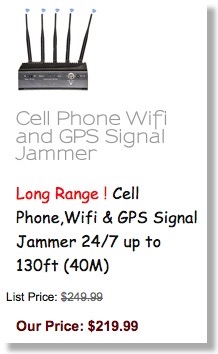
The NALs have the following text
Signal jamming devices operate by transmitting powerful radio signals that overpower,jam, or interfere with authorized communications. While these devices have been marketed withincreasing frequency over the Internet, with limited exception, they have no lawful use in the UnitedStates. (A footnote clarifies that federal agency use is a separate issue.)
Your blogger fully agrees that since FCC has never authorized any jamming, the import and use of such equipment is illegal. However, they also have the following text:
In order to protect the public and preserve unfettered access to emergency and other communications services, the Act generally prohibits the importation, use, marketing, manufacture, and sale of jammers.
This sentence is a more complicated issue and sounds more like CTIA’s interpretation of Section 333, the subject of CTIA’s 2007 petition that FCC has never acted on. (The petition also contained the issue of “cellular boosters” which was addressed and finally resolved in Docket 10-4 a few months ago.)
The issue of what Section 333 of the communications Act really means is also addressed in GTL’s July 2011 petition which is sitting without action in FCC’s petition “black hole”. Thus CTIA has repeatedly stated that Section 333 forbids FCC from even considering authorizing jamming in any context including nonfederal high security prisons. Somehow CTIA and NTIA have concluded this nonobvious reading of Section 333 does not affect NTIA at all. As GTL points out, this ignores the “inconvenient truth” that Section 305 only exempts federal use from Sections 301 and 303 of the Act and also that the analogous terms of 18 USC 1367, dealing with the special case of satellite jamming and passed contemporaneously with Section 333, explicitly excludes jamming by federal agencies while Section 333 is silent on special treatment of federal users.
But there is no question here that the new FCC NALs are consistent with the law.
Why were these 2 small private companies spending money on cellular jammers? Here is some explanation from the texts of the NALs:
The manager also claimed that Taylor Oilfield utilized the jamming devices to prevent its employees from using their cellular phones while working, apparently following a near miss industrial accident that allegedly was partially attributable to employee cell phone use.
The general manager also confirmed that Supply Room utilized the jamming devices to prevent its employees from using their cellular phones while working.
This is typical of the cellular industry’s lack of attention to the unintended consequences of its technology, In 2005 (the then existing) Motorola commissioned a study by Don Norman on “Minimizing the annoyance of the mobile phone: The Annoyance, Irritation, and Frustration of The Mobile Phone -- A Design Challenge”. Unfortunately today’s cellular industry doesn’t seem too interested in such issues. They do not view them as a “design challenge” rather as legal issues that must be acted on to help their industry.
From Comm Law Blog
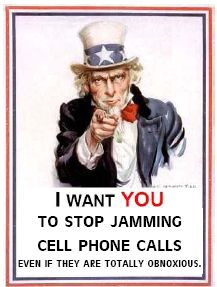
All complex new technologies have unintended consequences. As cellular expands the unintended consequences of these systems are becoming more visible. Shouldn’t the cellular industry address those issues more in addition to demanding more spectrum and more jammer enforcement?
How About Some Transparency in the Handling of Petitions?
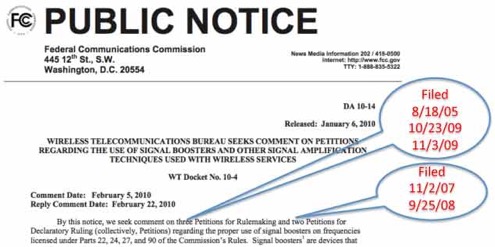
The right to petition the federal government is one guaranteed by the 1st Amendment and the APA (5 U.S.C. 553(e)). FCC has implemented this requirement with 47 C.F.R. 1.401. But all this means nothing if petitions fall into an administrative black hole where they can not be seen, let alone acted on!
The top of this post is a January 2010 FCC public notice (PN) asking for comment on 3 petitions for rulemaking and 2 petitions for declaratory rulings. As the annotations in red indicate, the oldest petition involved was almost 5 years old when the PN was released. (As can be seen in the dates above, all these petitions arrive prior to the current Chairman. This is a longstanding problem going back more than a decade.)
I did some discreet inquiries after this PN was issued and was surprised to find out that 8th Floor staffers do not have routine access to lists of petitions that have been filed or even petitions that are siting with action x months after filing. It as not even clear if the Chairman’s Office has routine access to this information. Petitions apparently go to bureaus and offices and just sit around until someone decides to act on them - or not. One always has the options of going to the District Court and asking for a writ of mandamus, but that is possibly the only option. Since the existence of these petitions can be secret, it is difficult for interested 3rd parties to find out about them and try to pressure/embarrass the Commission into acting.
Some modest suggestions:
1. The Commission create an internal tracking systems for such petitions and report all filings to all commissioners within a month of filing.
2. The Commission create a public tracking system, analogous to the FCC Items on Circulation webpage, that documents all petitions more than 3 months old that have not been acted on and makes the text available for public inspection. This need not be a PN requesting comment, just an acknowledgement that the petition has been filed and is under review.
"The FCC should be a model of openness, transparency, and a fair, data-driven process."
Julius Genachowski's confirmation hearing for FCC chairman before the Senate Science, Commerce, and Transportation Committee
(Emphasis added)
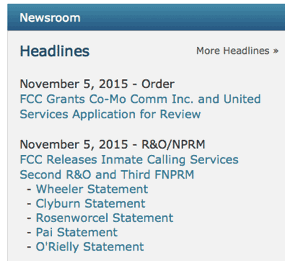




![Validate my RSS feed [Valid RSS]](valid-rss-rogers.png)

